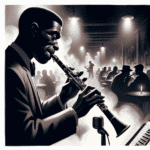Johnny Dodds was a legendary clarinetist whose work in the early 20th century helped shape the sound of jazz. Born in 1892 in New Orleans, Louisiana, Dodds became one of the most influential figures in jazz history, particularly recognized for his expressive playing and improvisational skills.
The Early Years
Growing up in the vibrant musical atmosphere of New Orleans, Dodds was surrounded by a rich blend of African, Caribbean, and European musical influences. He initially played the cornet but shifted to clarinet when he discovered his passion for it. Through listening to other musicians and immersing himself in the local jazz scene, he developed a unique voice that would later define his style.
Dodds joined the famed King Oliver's Creole Jazz Band at the young age of 16. His time with this band allowed him to hone his craft while performing alongside other musical greats such as Louis Armstrong and Jelly Roll Morton.
Innovations in Playing Style
Johnny Dodds is known for his distinctive sound on the clarinet, characterized by a strong, commanding tone and remarkable bending of notes, which was groundbreaking for his time. His techniques include:
- Expressive Vibrato: Dodds used vibrato to infuse emotion into his performances, making each note come alive with feeling.
- Alternate Fingerings: By experimenting with different fingerings, he added a unique timbre and color to his sound, creating a more dynamic auditory experience.
- Technique and Articulation: His quick articulation and ability to play passages cleanly at fast tempos set a new standard for future jazz clarinetists.
| Technique | Description | Impact |
|---|---|---|
| Expressive Vibrato | Controlled wavering of pitch | Enhanced emotional expression |
| Alternate Fingerings | Different finger positions for the same note | Unique timbre and tonal color |
| Swift Articulation | Clear and precise note separation | Cleaner passages at fast tempos |
Notable Recordings
Johnny Dodds left behind an extensive body of work that showcases his incredible talents. Some of his most recognized recordings include:
- “Jazz Boy Blues” – A demonstration of his vocal-like phrasing and rhythmic ingenuity.
- “Basin Street Blues” – A classic that features his skillful improvisation and melodic lines.
- “Dipper Mouth Blues” – Highlights his collaboration with Louis Armstrong, showcasing their mutual interplay and charm.
These recordings not only reveal Dodds' expertise but also offer a glimpse into the early jazz style that influenced his contemporaries and the generations that followed.
Influence on Future Generations
Dodds' impact on clarinet playing was significant. His contributions laid the groundwork for several styles that followed. Consider the following points:
- Impact on Jazz Clarinetists: His expressive playing style inspired numerous clarinetists like Buddy DeFranco and Benny Goodman, who built upon the techniques that Dodds popularized.
- Integration of Blues: Dodds incorporated elements of blues into his playing, enriching jazz with emotional depth and complexity that many others sought to achieve.
- Role Model: As a talented African American musician in a segregated America, Dodds served as a role model, showing that success in music was achievable through passion, skill, and innovation.
Johnny Dodds' Legacy Timeline
- 1892: Born in New Orleans, Louisiana
- 1908: Joins King Oliver's Creole Jazz Band at age 16
- 1920s: Records with Louis Armstrong and Jelly Roll Morton
- 1926: Records “Wild Man Blues” with Louis Armstrong
- 1930s: Continues performing and recording despite the Great Depression
- 1940: Passes away, leaving a lasting impact on jazz clarinet playing
Playing Techniques to Emulate
For aspiring clarinetists, studying Dodds' technique and style can offer valuable insights into developing one's own voice in music:
- Practice Improvisation: Learning to improvise is key for jazz musicians. Start by understanding Dodds' stylistic choices and practicing improvisation over familiar jazz standards.
- Master Articulation: Focus on crisp articulations and dynamic phrasing to capture the essence of Dodds' style.
- Expression through Vibrato: Work on developing a controlled vibrato that can enhance musical expressions, allowing for a personal touch in performances.
Conclusion
Johnny Dodds remains a towering figure in the history of jazz clarinet. His innovative techniques, heartfelt performances, and influential recordings continue to inspire both seasoned musicians and students alike. By studying his contributions, we can gain a deeper appreciation for the art of clarinet playing while continuing to evolve and grow in our musical journeys.







